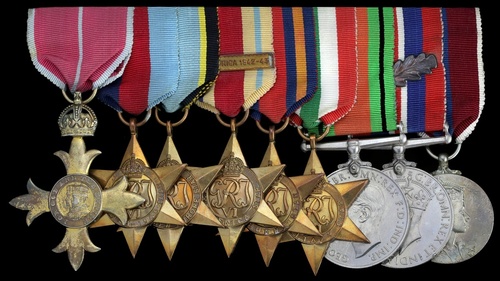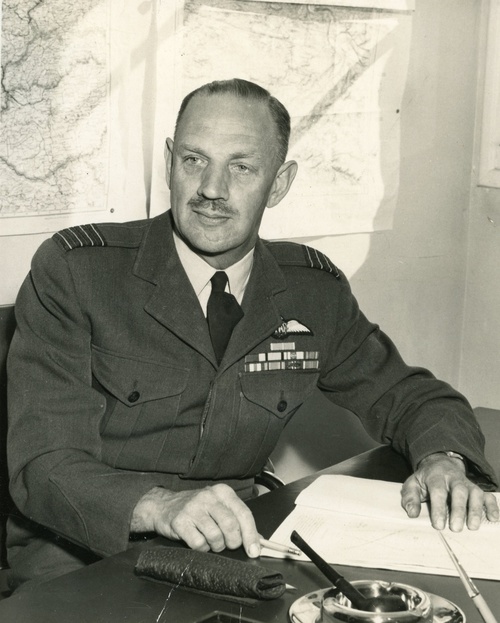Auction: 18001 - Orders, Decorations and Medals
Lot: 21
Sold by Order of a Direct Descendant
'I haven't thanked you properly yet for looking after me during those dreadful hours at Ardalsnes and Henn. I really think that your courage and perseverance saved my life - or worse still I might now be sitting in a concentration camp rather than a comfortable hospital … '
Squadron Leader Whitney Straight, the well-known pre-war racing driver, writing to Wing Commander L. T. Keens, following his rescue from Norway; Straight was awarded the M.C. in the London Gazette of 1 January 1941, the same gazette announcing Keens' O.B.E. for like services in Norway.
A rare and interesting Second World War Norway 1940 operations O.B.E. group of nine awarded to Group Captain L. T. Keens, Royal Air Force
Given command of 'X' Force, the small party of R.A.F. personnel charged with establishing airstrips on Norway's frozen lakes, Keens played host to the Gladiators of No. 263 Squadron on Lake Lesjeskogen until the Luftwaffe reduced his 'command' to ashes and just one aircraft remained serviceable
His subsequent actions in getting his force - and casualties - evacuated by the Royal Navy were heroic in the extreme
The Most Excellent Order of the British Empire (O.B.E.), Military Division, Officer's 2nd type breast badge; 1939-45 Star; Air Crew Europe Star; Africa Star, clasp, North Africa 1942-43; Burma Star; Italy Star; Defence and War Medals 1939-45; Coronation 1953, mounted as worn, generally good very fine (9)
O.B.E. London Gazette 1 January 1941.
Leonard Thomas Keens was born on 12 May 1908 and originally enlisted as a Gunner in the Royal Artillery (Territorials) in September 1925. In the following year he was granted a short service commission in the Royal Air Force and he qualified for his 'Wings' in April 1927.
He enjoyed a number of squadron postings over the next decade or so and was serving as a Squadron Leader with command of No. 21 Squadron, a Blenheim unit, on the outbreak of war in September 1939. In the following year, at short notice, he was ordered to Norway with command of 'X' Force, a party of six officers and 60 R.A.F. personnel charged with locating - and preparing - airstrips in Norway.
'X' Party - Norway 1940
Keens and his force were embarked in H.M.S. Arethusa on 21 April 1940 and arrived at Andalsnes at midnight on the 22nd. The following day they travelled by road to Lake Lesjeskogen, some 40 miles from Andalsnes:
'Snow covered the lake and its surroundings to a depth of 18 inches, but a runway, 800 yards long and 40 yards wide was cleared down the centre of the lake … final preparations were made for receiving the aircraft and early on the afternoon of the 24th No. 263 Squadron, now 250 miles off shore, in the aircraft carrier Glorious, flew off to land. Led by Skuas of the Fleet Air Arm, it took off in two flights and the 18 machines were landed without mishap on the lake's runway at 7 o'clock in the evening. By this time a Naval Oerlikon Battery from H.M.S. Excellent had mounted its guns in position by the aerodrome petrol dump and was ready for action.'
They didn't have to wait long. Contact with the enemy began at 04.45 hours on the 25th and remained almost continuous until the 26th, by which time all but one of 263's Gladiators had been destroyed and Keens' command generally laid waste:
'Under unbelievably difficult conditions, with inadequate servicing facilities, frozen-up machines and the runway becoming progressively worse from enemy attacks, the Squadron made a total of 31 interceptions resulting in six enemy aircraft shot down and eight others put out of action. By the evening thirteen out of their eighteen aircraft had been destroyed; but they were still able on the next day to deliver ground attacks on the enemy at Kvan, and damage two Heinkel IIIs before their petrol was exhausted and they were reduced to an attempt at re-servicing the sole remaining machine.'
Of those final flights flown on the 26th - and owing to the lake's runway being 'riddled with bomb craters' - the last few Gladiators operated from an emergency landing strip atop a small plateau at the entrance to the valley overlooking Andalsnes.
On the 29th, Keens' party undertook a 20-mile march to the village of Alfarness on Lang Fjord, from which it was hoped they could be evacuated. Keens and Squadron Leader Whitney Straight remained in Andalsnes to learn what they could of those evacuation plans. The Town was now under regular and heavy attack by the Luftwaffe and, on the next day, Whitney Straight was seriously wounded. He was evacuated to the hospital at Henn.
All British casualties that were fit to be moved were subsequently cleared from the hospital at Henn, Keens making a special journey to collect them. A 'harrowing' journey to the village of Alfarness ensued, a journey undertaken in the darkness and along a cliff road. There, at midnight on the 30th, Keens and his men were embarked in the destroyers Wanderer and Sikh. They reached Scapa Flow safely on 2 May.
Post-Norway
Keens was posted to Hawkinge towards the end of May 1940, where he was given charge of signals. Given mounting Luftwaffe operations, his flight - in a Tiger Moth - to Rouen on the 23rd appears to be a very gutsy one; he was charged with establishing a W./T. unit at Chateau Frankville.
In the following month he was posted to H.Q. No. 26 Group, followed by a move to the Middle East in March 1941. His skills as a senior signals officer were much in demand, for he was ordered to India in July 1942 and to the Mediterranean Air Command in March 1943, the former appointment having included several months with 167 Wing in Burma. Having then been involved in the Sicily and Italy operations and been mentioned in despatches (London Gazette 14 January 1944, refers), he re-joined No. 26 Group in April 1944.
Keens ended the war in command of R.A.F. Madley and, having attended the Staff College at Bracknell, he was advanced to Group Captain in October 1946. One of his final appointments was as Deputy Assistant Chief of Staff Communications for the Allied Air Force Central Europe (A.A.F.C.E.) at Fontainebleau and he was placed on the Retired List in October 1956.
Sold with a quantity of original documentation, including:
(i)
The recipient's R.A.F. Pilot's Flying Log Books (3), the first a Book 425 type covering the period May 1926 to March 1920, with inserted photographs and privately bound; the second a Form 414 type covering the period April 1930 to June 1936 and the third, another 414 type, the period July 1936 to September 1958.
(ii)
A comprehensive file of documents relevant to Force 'X' and Norway 1940, including the recipient's typed account of events, related Air Ministry correspondence and instructions, and a mass of fascinating field messages; together a with wartime map of Norway.
(iii)
A letter to the recipient from Squadron Leader Whitney Straight, written at a military hospital in Manchester on 16 May 1940, in which he thanks Keens for his gallantry in saving his life in Norway.
(iv)
A selection of career photographs.
Subject to 20% VAT on Buyer’s Premium. For more information please view Terms and Conditions for Buyers.
Sold for
£1,100







